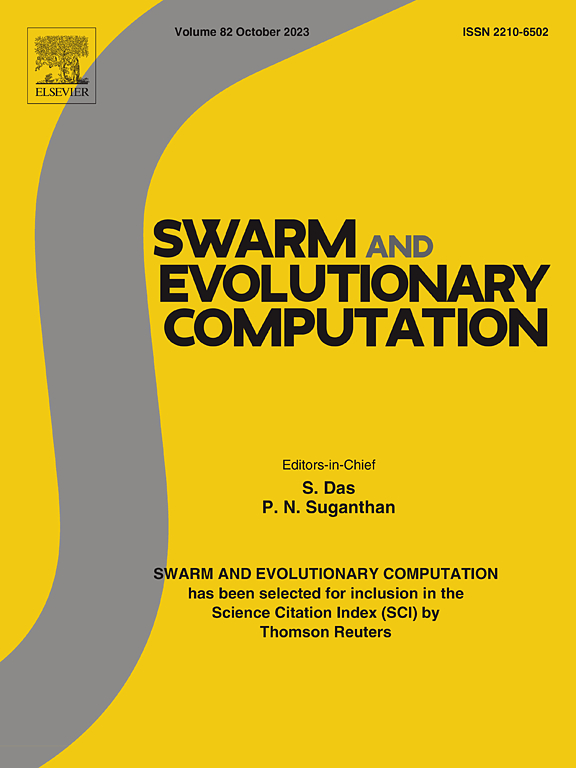A dueling double deep Q network assisted cooperative dual-population coevolutionary algorithm for multi-objective combined economic and emission dispatch problems
IF 8.2
1区 计算机科学
Q1 COMPUTER SCIENCE, ARTIFICIAL INTELLIGENCE
引用次数: 0
Abstract
With the increasing demand for electricity and the awareness of environmental protection, requirements for economic efficiency and controlling environmental impact of the power system are increasing. However, traditional power system scheduling usually focuses on ensuring the stability of the power supply, which neglects the optimization of cost and emissions. Therefore, combined economic and emission dispatch (CEED) problem is proposed to overcome this challenge. Due to nonlinear and nonconvex objective functions and narrow feasible regions, the optimization of multi-objective CEED problem encounters many difficulties. A dueling double deep Q network-assisted cooperative dual-population coevolutionary algorithm (D3QN![]() CDCA) is developed to solve multi-objective CEED problems. The proposed algorithm utilizes D3QN to select operators dynamically and adaptively for two populations of coevolutionary algorithm, thus enhancing its adaptability to different practical constrained multi-objective problems and satisfying search needs of different iteration stages. The introduction of D3QN is to overcome the inherent overestimation of DQN and improve the learning efficiency of the network. To comprehensively evaluate its performance, we tested D3QN
CDCA) is developed to solve multi-objective CEED problems. The proposed algorithm utilizes D3QN to select operators dynamically and adaptively for two populations of coevolutionary algorithm, thus enhancing its adaptability to different practical constrained multi-objective problems and satisfying search needs of different iteration stages. The introduction of D3QN is to overcome the inherent overestimation of DQN and improve the learning efficiency of the network. To comprehensively evaluate its performance, we tested D3QN![]() CDCA on benchmark function sets and applied it to CEED problems in comparison with other competitive algorithms. Results demonstrate that D3QN
CDCA on benchmark function sets and applied it to CEED problems in comparison with other competitive algorithms. Results demonstrate that D3QN![]() CDCA outperforms existing methods with an average IGD+ ranking of 1.4286 and an average HV ranking of 1.321 in benchmark function sets. Meanwhile, the proposed algorithm achieves an average improvement of 23.86 % in 6-unit, 23.12 % in 11-unit and 13.51 % in 14-unit CEED problems. The improvement in solution quality demonstrates the effectiveness of D3QN
CDCA outperforms existing methods with an average IGD+ ranking of 1.4286 and an average HV ranking of 1.321 in benchmark function sets. Meanwhile, the proposed algorithm achieves an average improvement of 23.86 % in 6-unit, 23.12 % in 11-unit and 13.51 % in 14-unit CEED problems. The improvement in solution quality demonstrates the effectiveness of D3QN![]() CDCA in solving high-dimensional multi-objective optimization problems, particularly in CEED, highlighting its potential for real-world energy management applications.
CDCA in solving high-dimensional multi-objective optimization problems, particularly in CEED, highlighting its potential for real-world energy management applications.
多目标联合经济与排放调度问题的双深度Q网络协同双种群协同进化算法
随着人们对电力需求的增加和环保意识的增强,对电力系统的经济性和控制环境影响的要求也越来越高。然而,传统的电力系统调度通常侧重于保证供电的稳定性,而忽略了成本和排放的优化。为此,提出了经济与排放联合调度(CEED)问题。由于目标函数的非线性和非凸性以及可行域的狭窄,多目标CEED问题的优化遇到了许多困难。针对多目标CEED问题,提出了一种双深度Q网络辅助的协同双种群协同进化算法(D3QNCDCA)。该算法利用D3QN对两类协同进化算法动态自适应选择算子,增强了算法对不同实际约束多目标问题的适应性,满足了不同迭代阶段的搜索需求。引入D3QN是为了克服DQN固有的高估,提高网络的学习效率。为了全面评估其性能,我们在基准函数集上测试了D3QNCDCA,并将其应用于CEED问题,与其他竞争算法进行了比较。结果表明,D3QNCDCA在基准函数集上的平均IGD+排名为1.4286,平均HV排名为1.321,优于现有方法。同时,该算法在6单元、11单元和14单元CEED问题上的平均改进率分别为23.86%、23.12%和13.51%。解决方案质量的提高证明了D3QNCDCA在解决高维多目标优化问题方面的有效性,特别是在CEED中,突出了其在实际能源管理应用中的潜力。
本文章由计算机程序翻译,如有差异,请以英文原文为准。
求助全文
约1分钟内获得全文
求助全文
来源期刊

Swarm and Evolutionary Computation
COMPUTER SCIENCE, ARTIFICIAL INTELLIGENCEC-COMPUTER SCIENCE, THEORY & METHODS
CiteScore
16.00
自引率
12.00%
发文量
169
期刊介绍:
Swarm and Evolutionary Computation is a pioneering peer-reviewed journal focused on the latest research and advancements in nature-inspired intelligent computation using swarm and evolutionary algorithms. It covers theoretical, experimental, and practical aspects of these paradigms and their hybrids, promoting interdisciplinary research. The journal prioritizes the publication of high-quality, original articles that push the boundaries of evolutionary computation and swarm intelligence. Additionally, it welcomes survey papers on current topics and novel applications. Topics of interest include but are not limited to: Genetic Algorithms, and Genetic Programming, Evolution Strategies, and Evolutionary Programming, Differential Evolution, Artificial Immune Systems, Particle Swarms, Ant Colony, Bacterial Foraging, Artificial Bees, Fireflies Algorithm, Harmony Search, Artificial Life, Digital Organisms, Estimation of Distribution Algorithms, Stochastic Diffusion Search, Quantum Computing, Nano Computing, Membrane Computing, Human-centric Computing, Hybridization of Algorithms, Memetic Computing, Autonomic Computing, Self-organizing systems, Combinatorial, Discrete, Binary, Constrained, Multi-objective, Multi-modal, Dynamic, and Large-scale Optimization.
 求助内容:
求助内容: 应助结果提醒方式:
应助结果提醒方式:


